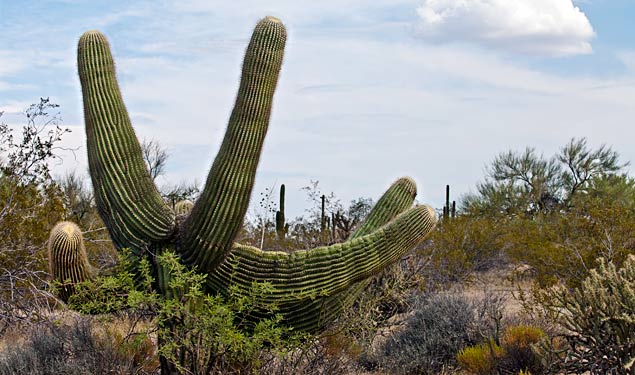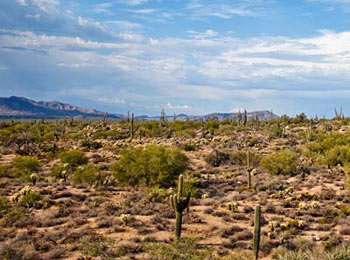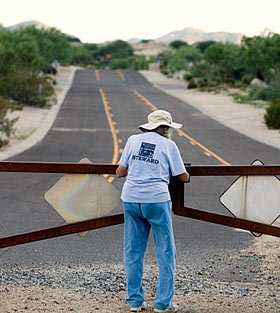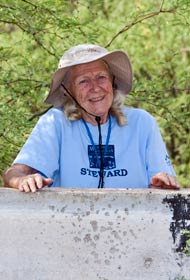

Photograph © Tom Brownold
The extreme clarity of the desert light is equaled by the extreme individuation of desert life-forms. Love flowers best in openness and freedom. — Edward Abbey
History of Sonoran Desert

Photograph © Tom Brownold
Arizona’s Sonoran Desert was first inhabited during the Archaic period (7000 BCE to 400 CE), when hunters and gatherers wandered the mountains and surrounding foothills. The Hohokam were the first to settle the lands and, from 100 to 1450 CE, creating an extensive system of towns in the valley where Phoenix, Mesa, Tempe, and Scottsdale now exist. The Hohokam settled near rivers and built canal systems to raise crops like corn, beans, squash, and cotton. The original settlers were followed by the hunter and gatherer Yavapai and Apache cultures and the settlements began to decline.
While the Sonoran Desert environment can be harsh and difficult for human habitation, it hosts the greatest diversity of vegetative growth of any desert worldwide, making it a prime location for gatherers. The Arizona upland section, in particular, features bi-seasonal rainfall and extensive species diversity and richness. Almost 400 plant species, including the largest of all cactus, the saguaro cactus (Carnegiea gigantean), and the nurturing ironwood (Olneya tesota) and palo verde (Parkinsonia microphylla) trees, and many wildlife species, such as the ubiquitous Bailey's pocket mouse, Gila monster, mountain lion, coyote, and jackrabbit, inhabit the complex landscape.
By the end of the Civil War, the U.S. government sent large numbers of troops west to suppress the Native American nations and open the land for development of mining, ranching, and farming. Federal troops built Ft. McDowell in 1865 as a permanent station and the local Yavapai and Apache bands were removed to reservations. Ranching and mining endeavors in the area expanded and, in 1888, retired military chaplain, Winfield Scott, moved to the region and founded the settlement of Scottsdale.
In the years leading up to World War II, the aircraft industry began to utilize the desert for flight training, relocating production facilities along with needed infrastructure. This transformed the agricultural economy into a predominantly industrial one. Wartime activities introduced the region to thousands of young defense contractors and military personnel, who would remain or return to settle in the area when their war duties ended. The post-war population surged from 2,000 in 1950 to more than 225,000 by 2000.
In 1991, long-time Sonoran resident Jane Rau joined several other members of the community to co‐found the McDowell Sonoran Conservancy. The founders established the conservancy as a volunteer organization that would champion the preservation of the Sonoran Desert and its mountains. Since that time, under Ms. Rau’s leadership, the conservancy has grown into a dynamic organization of more than 400 trained volunteers contributing more than 200,000 hours building and maintaining trails, patrolling, leading hikers, and educating the public on the significance of the desert landscape.
Ms. Rau’s efforts to educate city leaders culminated in the development of a preservation plan for the region: a public/private venture that led voters to approve a sales tax increase referendum to purchase 16,000 acres of open space. Nearly 20,000 more acres have since been designated under the conservancy’s land trust auspices and the organization continues to work towards acquiring more property. When completed, the preserve will encompass nearly one‐third of Scottsdale’s land area, and constitute a significant habitat to the desert flora and wildlife. Ms. Rau continues to work with officials and the public as Director Emeritus of the McDowell Sonoran Conservancy to ensure progress continues.

Photograph © Tom Brownold
Threat
As the metropolitan areas continue to expand rapidly, agricultural operations are pushed further into the desert and along riparian areas such as the Verde River, which flows into the preserve, there is a tremendous impact on the wildlife habitat. Riparian habitats within the preserve are also threatened by non-native species such as the rapidly growing tamarisk tree (Tamarix spp.). The introduction of buffel grass (Pennisetum ciliare) for cattle grazing has been particularly harmful; accumulating in the preserve, forming combustible growth that burns at a higher heat (as opposed to native plants) and causing the burning of ironwood trees and other native plants that would normally survive a seasonal fire. The results: grasslands are replacing the desert scrub, thereby lowering or preventing the recurrence of perennials. These invasive animal and plant species displace native fauna and flora through direct competition for scarce ground water. This, coupled with the significant threat of illegal collection of plant and animal species and increasing tourism activities, threatens to further disturb the flora and the complex balance in which it thrives.

